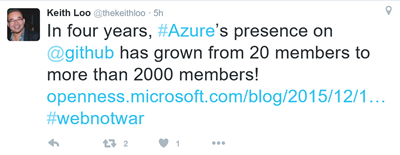DevOps Basics: Introduction to GitHub
During last years Build 2015, Microsoft announced GitHub extensions for Visual Studio 2015 enabling integration with the source-code repository startup. Furthermore GitHub has also been enabled to store code utilized on Azure. This enablement has made GitHub a popular programmer choice to collaborate on open-source project with other team members including those in IT.
Recently, the Microsoft Open Source community celebrated the recent growth of adoption pertaining to GitHub utilization on Azure.

With adoption continuing the grow and DevOps being a major motion continuing straight through 2016, this post was penned to help explain the capabilities of Git and GitHub and how the tools are to be used.
Terminology
Lets start with the basic terminology understanding of the tool itself:
- Git - an open source version control system with emphasis on data integrity and speed.
- GitHub - one of the world's largest Git repositories and a popular choice for developers collaborate and standardize code.
- Clone - the ability to create a copy of the central repository and enabling the copier to ability to manage said file versions and select specific file versions should it be required.
- Add - files added to a repository are now managed using version control (Git) and must be added before they can be shared for collaboration.
- Commit - when changes of a file are approved, they are committed locally to be synced amidst the shared repository in future.
- Push - once the changes locally are committed, they are then replicated to the central repository.
- Pull - invokes synchronization between the central repository and the local version of a file and is usually initialized to ensure consistency of a file before being worked on.
- Pull Request - a modification proposal of a file within the central repository made to the owner of said file/code for modification discussion.
The following is a great quick overview of how tools such as GitHub come into play during the DevOps process:
Tools are currently available to start testing Git functionality and can be downloaded here: https://aka.ms/getgithub
Once downloaded and installed, run the application and configure Git using the following command lines:
$ git config --global user.name "YOUR NAME"
$ git config --global user.email "YOUR EMAIL ADDRESS"
Once completed, be sure to read DevOps Basics: Infrastructure as Code – The Visual Studio Method to continue learning about Git and GitHub.